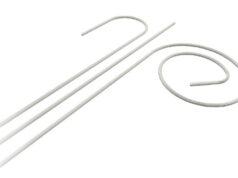
Randy Lieberman (Detroit, USA) explains how lead design for vagal nerve stimulation in heart failure treatment may affect the outcome of the procedures.
Vagal nerve stimulation has shown improvements in heart failure using several devices in many animal studies with stimulation currents adequate to reach cardiac effect. In animals, reports include improvements in haemodynamics and biomarkers that are associated with heart failure, such as nitric oxide and inflammatory markers.
In humans, an open label pilot study, conducted in Europe, using the CardioFit System (BioControl Medical) has shown improvement in clinical heart failure symptoms, New York Heart Association (NYHA) heart failure class and evidence of left ventricular reverse remodelling.
Recently, the results of two other human vagal nerve stimulation studies [NECTAR-HF and ANTHEM-HF] were presented at the European Society of Cardiology congress in Barcelona, Spain. While NECTAR-HF did not show improvements in the primary endpoint of reduction in left ventricular end-systolic diameter (LVESD), ANTHEM-HF demonstrated statistical improvement in left ventricular ejection fraction and LVESD in left and right vagal stimulation of chronic symptomatic heart failure patients.
The vagus nerve is composed of myelinated A fibres, myelinated B fibres and non-myelinated C fibres. It is generally accepted that it is necessary to stimulate the myelinated B fibres to obtain a cardiac effect.1
The stimulation threshold or minimum current necessary to activate the specific nerve fibre is different for each of the A, B, and C fibres and depends on myelination and fibre diameters.
Research data2 indicates that a minimum current target level of 2mA is required to achieve B fibre activation, and more B fibres are activated as current is increased.
As one titrates the stimulation current upward to activate B fibres, the likelihood of patient discomfort is increased as the current stimulates local tissue (eg. laryngeal area) and other adjacent nerves. Thus, the ability to achieve an adequate current level to activate B fibres is limited by clinical side effects and not the lack of an adequate energy source.
Therefore, when designing a vagal stimulation lead for cardiac use, one should consider the potential for current leakage and the ability to titrate the therapy to an optimal level for B fibre activation and minimal side effects.
All three trials recommended titration of current to maximal tolerated therapy. The authors of the ANTHEM-HF and NECTAR-HF studies stated that side effects limited the ability to achieve higher currents of stimulation. The lowest level of current was in the NECTAR-HF trial. At the ESC presentation, data showed 70% patients had current below 1.5mA. This trial had the least positive effect, showing improvement in symptoms of heart failure and no echocardiographic reverse remodelling. The ANTHEM-HF trial achieved a higher stimulation current (mean 2.0mA), and this trial demonstrated positive effect on echocardiographic reverse remodelling parameters with both right and left vagal stimulation. The BioControl Medical pilot trial achieved the highest current (mean 4.1mA) and demonstrated improvements in short-term and long-term clinical and echocardiographic parameters.
| BIOCONTROL MEDICAL | ANTHEM-HF | NECTAR-HF | |
| Target stimulation (mA) | 5.5 | 4.0 | 3.0 |
| Actual stimulation (mA) | 4.1±1.2 | 2.0±0.6 | 1.42±0.8 |
These trials suggest that there is a clinical dose response (mA), consistent with the knowledge of nerve fibre characteristics and animal model data. The CardioFit System was designed to achieve the necessary higher current for B fibre activation.
Currently, the INOVATE HF clinical trial, using the CardioFit System, is being conducted in 90 centres worldwide to evaluate the long-term safety and efficacy in patients. It is hoped that this trial will provide more definitive data on the safety and efficacy of vagal nerve stimulation for patients with heart failure.
References:
1. Jones JFX et al; Journal of Physiology 1995; 489.1:203-214
2. Yoo PB et al; Journal of Neural Engineering 2013; 10:2 026003
Randy Lieberman is director of Electrophysiology at Harper University Hospital, Detroit Medical Center, Detroit, USA. He is a consultant for BioControl Medical












